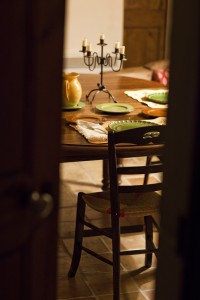My Jambon Cru
My Jambon Cru

On a bitter January day in 1973, I made my first jambon cru, France’s version of prosciutto, with a farmer in Provence. Marcel, my neighbor at the time, had a special wooden box that he used. He filled it half full with salt, then laid the fresh pork leg on top, then covered it all in salt and kept it in a cool place – namely a heavily vaulted stone room that would one day be transformed into the kitchen of my French house.

We checked on the ham every few days, turning it a few times, and captured the brine that accrued as the salt drew the moisture from the meat. After about 20 days, I helped him clean the ham and then rub it deep and thick with pepper, wild thyme and rosemary. He wrapped it in a clean pillowcase and hung it back in the stone room.
About 6 months later, he started bringing the ham up the stairs at lunch and dinner, putting it on the table and cutting slices from it to fill a platter. We ate the slices, fat and all, on top of thick slices of bread, before digging into whatever dish Marcel’s wife, Marie, had prepared. It could have been braised rabbit, stuffed cabbage, tripe stew (one of my favorites) and always some kind of pasta. Marie is Italian, from Calabria, and pasta is an indelible part of her life.
Not long after that I moved back to California from France and I took with me my memories of making Jambon Cru, but only in the last five or six years has making it again become a winter ritual. It was my husband’s idea to try it, and so I recounted my experience to him, step by step, emphasizing the importance of it being done in winter and that there be ventilation for the hanging process.

Now, there are nearly 20 people who usually join us, each with his or her own ham. My husband built special boxes for salting and all the salted hams get stored in our walk-in cooler. When it’s time for the rub, each person creates an individual rub – some include dried garlic, others paprika, pepper of course (helps keeps flies away) and varying amounts of sage, rosemary, thyme, and winter savory from our small farm.
 The hams are wrapped in cheesecloth, tagged and hung outside on the rafters of the breezeway between the walk-in cooler and a packing shed to cure. When the weather warms about 5 months later, like around now, the hams come down and go to their owners. Most everyone elects to take them to ‘Joe the Butcher’, our local butcher who cuts them into slabs and cryovacs them. At least to my thinking it’s not quite as romantic as bringing the whole ham to the table to cut a few slices, but it is more convenient.
The hams are wrapped in cheesecloth, tagged and hung outside on the rafters of the breezeway between the walk-in cooler and a packing shed to cure. When the weather warms about 5 months later, like around now, the hams come down and go to their owners. Most everyone elects to take them to ‘Joe the Butcher’, our local butcher who cuts them into slabs and cryovacs them. At least to my thinking it’s not quite as romantic as bringing the whole ham to the table to cut a few slices, but it is more convenient.

By the time next January comes, the jambon cru of this year will have made its way into pizzas, risottos, soups, sandwiches, charcuterie platters and this year, one of the appetizers for a family wedding. There will be just enough left to slice up and have the traditional last taste of the past year’s ham – with a glass or two of red wine – while salting down the new ham.
